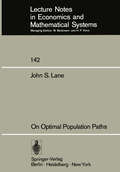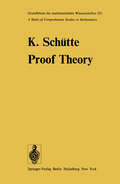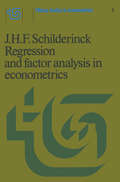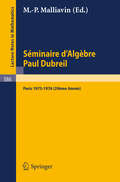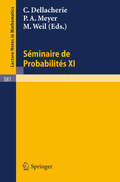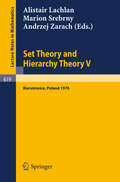- Table View
- List View
Obstruction Theory: On Homotopy Classification of Maps (Lecture Notes in Mathematics #628)
by H. J. BauesOdd Order Group Actions and Witt Classification of Innerproducts (Lecture Notes in Mathematics #625)
by John P. Alexander Pierre E. Conner Gary C. HamrickOn Optimal Population Paths (Lecture Notes in Economics and Mathematical Systems #142)
by J.S. LaneThe overall purpose of this monograph is to integrate and critically evaluate the existing literature in the area of optimal joint savings population programs. The existing diverse presentations are all seen to be discussions within a unified framework. The central problem is to compare the desirability of alternative inter-temporal sequences of total savings and population sizes. Of critical importance is whether one regards persons as the fundamental moral entities or whether one takes Sidgwick's viewpoint that something good being the result of one's action is the baSic reason for dOing anything. The latter viewpoint is consistent with defining a complete social preference ordering over these alternative sequences. Since part of one's interest is to evaluate the consequences of various ethical beliefs a com parative study of several such orderings is presented; in particular the Mill-Wolfe average utilitarian, and Sidgwick-Meade classical utilitarian) formulations. A possible problem with the social preference ordering approach is that the ordering may indicate the desirability of increasing the population size, if this increases the total amount of good, even though people may receive less than the welfare subsistence level of consumption. However, there are other ways of evaluating actions and, if persons are the fundamental moral entities, then perhaps these actions should be evaluated by their implications for the rights of individuals i. e. people Who are currently alive, people who one can predict will exist in the future (e. g.
p-adic Numbers, p-adic Analysis, and Zeta-Functions (Graduate Texts in Mathematics #58)
by NEAL KoblitzThese lecture notes are intended as an introduction to p-adic analysis on the elementary level. For this reason they presuppose as little background as possi ble. Besides about three semesters of calculus, I presume some slight exposure to more abstract mathematics, to the extent that the student won't have an adverse reaction to matrices with entries in a field other than the real numbers, field extensions of the rational numbers, or the notion of a continuous map of topolog ical spaces. The purpose of this book is twofold: to develop some basic ideas of p-adic analysis, and to present two striking applications which, it is hoped, can be as effective pedagogically as they were historically in stimulating interest in the field. The first of these applications is presented in Chapter II, since it only requires the most elementary properties of Q ; this is Mazur's construction by p means of p-adic integration of the Kubota-Leopoldtp-adic zeta-function, which "p-adically interpolates" the values of the Riemann zeta-function at the negative odd integers. My treatment is based on Mazur's Bourbaki notes (unpublished).
Probability Measures on Locally Compact Groups (Ergebnisse der Mathematik und ihrer Grenzgebiete. 2. Folge #94)
by H. HeyerProbability measures on algebraic-topological structures such as topological semi groups, groups, and vector spaces have become of increasing importance in recent years for probabilists interested in the structural aspects of the theory as well as for analysts aiming at applications within the scope of probability theory. In order to obtain a natural framework for a first systematic presentation of the most developed part of the work done in the field we restrict ourselves to prob ability measures on locally compact groups. At the same time we stress the non Abelian aspect. Thus the book is concerned with a set of problems which can be regarded either from the probabilistic or from the harmonic-analytic point of view. In fact, it seems to be the synthesis of these two viewpoints, the initial inspiration coming from probability and the refined techniques from harmonic analysis which made this newly established subject so fascinating. The goal of the presentation is to give a fairly complete treatment of the central limit problem for probability measures on a locally compact group. In analogy to the classical theory the discussion is centered around the infinitely divisible probability measures on the group and their relationship to the convergence of infinitesimal triangular systems.
Probability Theory I (Graduate Texts in Mathematics #45)
by M. LoeveThis fourth edition contains several additions. The main ones con cern three closely related topics: Brownian motion, functional limit distributions, and random walks. Besides the power and ingenuity of their methods and the depth and beauty of their results, their importance is fast growing in Analysis as well as in theoretical and applied Proba bility. These additions increased the book to an unwieldy size and it had to be split into two volumes. About half of the first volume is devoted to an elementary introduc tion, then to mathematical foundations and basic probability concepts and tools. The second half is devoted to a detailed study of Independ ence which played and continues to playa central role both by itself and as a catalyst. The main additions consist of a section on convergence of probabilities on metric spaces and a chapter whose first section on domains of attrac tion completes the study of the Central limit problem, while the second one is devoted to random walks. About a third of the second volume is devoted to conditioning and properties of sequences of various types of dependence. The other two thirds are devoted to random functions; the last Part on Elements of random analysis is more sophisticated. The main addition consists of a chapter on Brownian motion and limit distributions.
Programmieren von Taschenrechnern: 1 Lehr- und Übungsbuch für den SR-56 (Programmieren von Taschenrechnern #1)
by Hans Heinrich GloistehnQuarks and Hadronic Structure (International Physics Workshop Series #1)
by Giacomo MorpurgoOne of the activities of the Ettore Majorana Centre for ,Scientific Culture is the international advanced study courses on scientific topics which are of particular relevance today. The Centre is located in Erice, a mountain town in the province of Trapani in Sicily. At present over seventy Schools of the Centre are active, holding annual or biennial courses, so that about forty courses are organized each year. To date some twenty thou sand participants have attended the courses of the various Schools of the Centre. The International Physics Workshop Series has been established to make the contents of the Workshops o'f great topical interest available to those who were unable to attend them. The courses are conducted on an advanced, post-doctoral level. This volume - the proceedings of the session on "Quarks and Hadronic Structure" - is the first of the Series. In September 1975, thirty-three physicists from twenty-one laboratories in nine countries met in Erice to attend the Workshop. The countries represented were: Austria, France, Germany, India, Italy, Poland, Switzerland, the United Kingdom, and the United States of America. The purpose of this Workshop was to bring to gether a group of theorists working on various aspects of the quark structure of hadrons to discuss and critically evaluate the present situation. Professor Morpurgo was given the direction of the Workshop. I would like to take this opportunity to thank him most warmly for having accepted this responsibility and for the success of the Work shop.
Reelle und Vektorwertige Quasimartingale und die Theorie der stochastischen Integration (Lecture Notes in Mathematics #607)
by M. MetivierRegression and factor analysis applied in econometrics (Tilburg Studies in Econometrics #1)
by J.H.F. SchilderinckThis book deals with the methods and practical uses of regression and factor analysis. An exposition is given of ordinary, generalized, two- and three-stage estimates for regression analysis, the method of principal components being applied for factor analysis. When establishing an econometric model, the two ways of analysis complement each other. The model was realized as part of the 'Interplay' research project concerning the economies of the European Common Market countries at the Econometrics Department of the Tilburg School of Economics. The Interplay project aims at: a. elaborating more or less uniformly defined and estimated models; b. clarifying the economic structure and the economic policy possible with the linked models of the European Community countries. Besides the model for the Netherlands published here, the models for Belgium, Italy, West Germany and the United Kingdom are ready for linking and for publishing later on. The econometric model presented in this book and upon which the Interplay model is based comprises eleven structural and twenty-one definitional equations; it is estimated with ordinary, two- and three-stage least squares. The analysis of the model is directed at eliminating multicollinearity, accor ding to D.E. Farrar's and R. Glauber's method. In practice, however, complete elimination of multicollinearity leads to an exclusion of certain relations which is not entirely satisfactory. Economic relations can be dealt with more fully by analyzing the variables involved in detail by factor analysis. In this study factor analysis is also a suitable method for a comparative analysis of different periods.
Relevanz und Entwicklung der Psychologie: Die Krisen-Diskussion in der amerikanischen Psychologie, Probleme einer psychologischen Technologie und die Suche nach einem neuen Paradigma (Psychologie und Gesellschaft #1)
by F. SeegerScattering Theory for Automorphic Functions. (AM-87), Volume 87
by Peter D. Lax Ralph S. PhillipsThe application by Fadeev and Pavlov of the Lax-Phillips scattering theory to the automorphic wave equation led Professors Lax and Phillips to reexamine this development within the framework of their theory. This volume sets forth the results of that work in the form of new or more straightforward treatments of the spectral theory of the Laplace-Beltrami operator over fundamental domains of finite area; the meromorphic character over the whole complex plane of the Eisenstein series; and the Selberg trace formula. CONTENTS: 1. Introduction. 2. An abstract scattering theory. 3. A modified theory for second order equations with an indefinite energy form. 4. The Laplace-Beltrami operator for the modular group. 5. The automorphic wave equation. 6. Incoming and outgoing subspaces for the automorphic wave equations. 7. The scattering matrix for the automorphic wave equation. 8. The general case. 9. The Selberg trace formula.
Selection in One- and Two-Locus Systems (Lecture Notes in Biomathematics #15)
by T. NagylakiMost of these notes were presented as part of a two-quarter course on theoretical population genetics at The University of Chicago. Almost all the students were either undergraduates in mathematics or graduate students in the biological sciences. The only prerequisites were calculus and matrices. As is done in these notes, biological background and additional mathematical techniques were covered when they were required. I have included the relevant problems assigned in the course. My aim in these notes is to formulate the various models fairly generally, making the biological assumptions quite explicit, and to perform the analyses relatively rigorously. I hope the choice and treatment of topics will enable the reader to understand and evaluate detailed analyses of specific models and applications in the literature. No attempt has been made to review the literature or to assign credit. Most of the references are to papers directly germane to the subjects and approaches covered here. Frequency of reference is not intended to reflect proportionate contribution. I am very grateful to Professor James F. Crow for helpful comments and to Mrs. Adelaide Jaffe for her excellent typing. I thank the National Science Foundation for its support (Grant No. DEB76-01550).
Séminaire d'Algèbre Paul Dubreil: Paris 1975-1976 29ème Année (Lecture Notes in Mathematics #586)
by M. P. MalliavinSeminaire de Probabilites XI: Universite de Strasbourg (Lecture Notes in Mathematics #581)
by C. Dellacherie P. A. Meyer M. WeilSet Theory and Hierarchy Theory V: Bierutowice, Poland 1976 (Lecture Notes in Mathematics #619)
by A. Lachlan M. Srebrny A. ZarachThe Significance of Nonlinearity in the Natural Sciences (Studies in the Natural Sciences #13)
by Stephan MintzIn accordance with the established tradition of these annual meetings under the aegis of Orbis Scientiae we have, this year, included the very important field of "The Significance of Non linearity in the Natural Sciences." We are pleased to join many scientists in recognizing the nonlinearity arising from the under lying interaction of all natural phenomena. It is tempting to say that in the long run things are nonlinear and that we shall have to design new techniques and methods to solve nonlinear equations. This year's Orbis Scientiae did include four sessions on nonlinear equations pertaining to elementary particle physics, molecular physics, fluid dynamics, and also to biology. Our Center intends to pursue the inclusions of these topics in its future Orbis Scientiae. Appreciation is extended to Mrs. Helga S. Billings, Mrs. Elva Brady, and Ms. Yvonne L. Leber for their skillful typing of the proceedings, which they have performed with great enthusiasm and dedication. The Editors v CONTENTS Some Recent Developments on Solitons in Two-Dimensional Field Theories 1 Andre Neveu Path Integral Quantization of Solitons. . . . . . . . . . 17 A. Jevicki Nontopological Solitons 39 R. Friedberg Vacuum Bubble Instantons 57 P. H. Frampton Nonlinear Deep Water Waves: A Physical Testing Ground for Solitons and Recurrence . . . . . 67 Henry C. Yuen and Bruce M. Lake Solitons as Particles, and the Effects of Perturbations . . . . 97 D. J. Kaup The Formulation of Variational Principles by Means of Clebsch Potentials .


